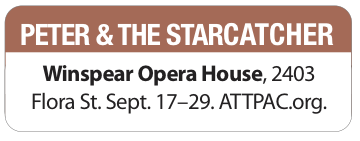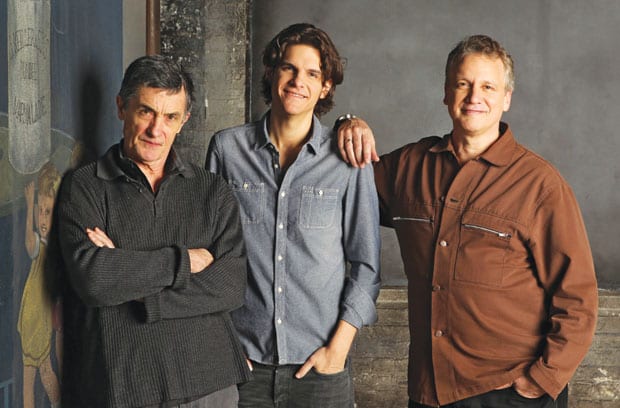‘Peter and the Starcatcher’ author Rick Elice on partnering with a partner

DREAM TEAM | Tony-winning actor and former ‘Cheers’ star Roger Rees, left, and his partner Rick Elice, right, developed their ‘Peter Pan’ retelling with Alex Timbers, center. (Photos by Joan Marcus)
ARNOLD WAYNE JONES | Life+Style Editor
 Before Rick Elice came to write Peter and the Starcatcher — the hugely successful “play with music” that serves as a kind of prequel to the Peter Pan story, which opens Tuesday at the Winspear — he didn’t know much about the source material.
Before Rick Elice came to write Peter and the Starcatcher — the hugely successful “play with music” that serves as a kind of prequel to the Peter Pan story, which opens Tuesday at the Winspear — he didn’t know much about the source material.
“Of course, I knew there was a man with a hook for a hand, and a boy who never grew up, and I probably saw the musical version with Sandy Duncan or Cathy Rigby at some point,” he says from his home in New York. Other than that, he hadn’t thought about the show much; he more closely associated Peter Pan with peanut butter than high theatrical achievement.
It was luck, then, that of the two men originally approached in 2007 to adapt the Dave Barry/Ridley Pearson children’s novel to the stage, one (Alex Timbers) was Elice’s close friend, and the other (Roger Rees) was his husband. (They married in 2011.) Timbers and Rees were interested in the project, but neither had the time to commit to more than a one-time-only workshop version.
“As a friend of the court, they asked me to write [the dialogue],” Elice says. “They needed someone who would say yes and do it without contracts or lawyers or, god forbid, money. So suddenly I was writing a play,” which Timbers and Rees would direct.
It wasn’t like Elice was a novice at playwriting. He received a Tony Award nomination as co-author (with Marshall Brickman) of Jersey Boys, and wrote the book to The Addams Family musical. A play would be a piece of cake.
Only it wasn’t. The book on which it is based, Peter and the Starcatchers, is a 500-page tome targeted to a young audience; Timbers and Rees both wanted something more adult, with saucy language and mature themes. How was Elice going to pare down the novel? And what was the appeal of the Peter Pan story anyway?
The latter question was actually easier to answer.
“I think the fascination with this character, who captured the imagination [of audiences] 110 years ago, is, there’s something about the idea of this eternal man-child that’s really recognizable to us as men. It’s why therapists have a Peter Pan complex that only applies to males. There’s something in our DNA about not wanting to get older, and how fantastic it would be to not have anyone tell you what to do,” he says. But that’s also a false goal.
“If I hadn’t gotten past the age of 13, I wouldn’t have done all of the stuff that made me feel happy and have a life — I never would have fallen in love or had sex or fought for anything I really cared about and won, or fought and lost, or have a sense for my moral place in the world. If all of that had been kept from me, we certainly wouldn’t be having this conversation.” The desire to explore those feeling fueled what was a casual writing assignment into a personal passion.
The problem remained, though: How could he create this backstory to Peter Pan in a format that could be told theatrically in two hours? That’s where the genius of Rees and Timbers came in.
“I needed some really strong organizing principles,” he says. “Roger and Alex [proposed thinking of it as] a smaller-scale version of what a Disneyfied version presented by a small troupe. When they did the first lab, working entirely from the novel, they used what they had available — a rope, a bucket, some sticks, some acting interns and their imaginations.”
They also gave him the act structure: The first half is set on the cramped, claustrophobic quarters of ships at sea; the second half on an island with bright skies and open spaces.
More than that, “the actors would play every thing — the natives, the children, adults, doors, masts, storms, jungles … and they would all narrate the action. So each of the actors would have a privileged relationship with the audience, not just one narrator,” Elice explains. The idea, in essence, was to merge the post-modern irreverence of the novel with James Barrie’s original Victorian style.
“James Barrie used high-comedy and low, bawdy humor, broad physical gags and sounds and metatheatrical anachronisms to reel in the audience, then he would sneak up and deliver sentiment deftly. I wanted to merge those very disparate styles, to see if I could create some connective tissue,” he explains.
It’s a hodgepodge that worked. The Broadway production was a critical and popular hit, winning five Tony Awards out of nine nominations, including two for Elice himself. (Ironically, Elice lost the Tony for best play to Clybourne Park, which opens at the Dallas Theater Center next month.) Still, he admits his adaptation is pretty liberal with both sources.
“In my version of their story — which Ridley and Dave were very graceful to allow me to invent, as long as I make it fun — I dropped the S from the novel’s title to make it not about this boy and Starcatchers, but about this boy and this one girl,” he explains. “I wanted to explore what it was like to be disenfranchised and not have a seat at the table. In my play, he’s an orphan who doesn’t even remember what his name might have been, living in a Dickensian situation — a kid afraid of his own shadow who’s never been out in the daylight.”
The female character — who’s not Wendy — is his mirror image: “The kind of strong, smart, super-articulate girl like Scout Finch or Jo March, a too-smart girl with no friends who meets another outsider.” (The outsider theme resonated with Elice. “He could be Peter Pan or a gay kid or a fat kid or anything we ostracize people for,” he explains.)
Putting together a play is challenging enough when you’re not married to one of the directors; when you are, things get complicated.
“Roger and I had written a play together before, and he has directed some productions of it, and it’s hard. You want to be able to come home and say [to your partner], ‘That motherfucker!’ but you can’t because it’s the same person,” he laughs. Still, the process was easier than it could have been because of the passions on all sides.
“So much of this [play] was Roger and Alex’s baby. For me, it was like a master class in directorial sensibilities and theater tradition and theatrical writing technique. Between the two of them, there’s probably nothing they don’t know — they’re so smart and talented. Peter and the Starcatcher started very casually for me, but it became a real passion project because of our relationship.”
Still, there are more goals to achieve. Elice is currently reteaming with Brickman, his Jersey Boys collaborator, on a new musical. “Is is called Connecticut Girls?” I ask. He laughs.
“I wish it were that easy.“
This article appeared in the Dallas Voice print edition September 13, 2013.

